
25 minute read
The Shoulder Sleeve Insignia of the Fourth Brigade of Marines, 1918–19
U. S. Army Gold Team Prizes, 1906–1923
Lt. Col. William K. Emerson, USA (Ret.)
Advertisement
The purpose of this article is to provide data and show examples of wearable gold prizes given to Regular Army officers and enlisted men between 1906 and 1923 who were members of various branch teams that participated in the National Rifle Team Matches. The prizes came in four different versions and the Army awarded less than 460 of these gold medals. Given the Army’s many other gold, silver, and bronze prizes in existence during the early twentieth century, why did the Army create the gold team prize? After a quick synopsis of the Army’s competitive shooting program and awards, this article will look at these gold medals and then quickly discuss their follow-on prizes.
The U.S. Army had, in 1858, started recognizing the best long arm shooter in a company with the award of a wearable brass stadia and the best regimental marksman with a silver stadia.1 Despite this, the Army did not really push rifle and carbine training until the late 1870s.
In 1875, under the leadership of George W. Wingate of the National Guard, State of New York, the state introduced an award that any National Guard member could earn if he obtained a sufficiently high score during the annual rifle firing.2 Soon several other states followed. Very quickly qualification firing where a soldier might earn a badge grew into a military craze. In 1879 Col. T. T. S. Laidley, commander of Watertown Arsenal, published a manual, Course of Instruction in Rifle Firing, which outlined the Regular Army’s approach to marksmanship training. Soon Colonels Laidley and Wingate were heavily involved in charges and counter charges of copyright infringement—an indication of the new nation-wide interest in marksmanship.3 From the late 1870s until after the Spanish American War, most states developed a wide range of marksman buttons that, over time, became very diverse.
FIG 2. An original bronze marksman bar issued by the Regular Army in 1884 (top). Initially these were given to soldiers who had earned marksman buttons for three years. Below is a silver marksman bar that replaced the bronze version in 1885. In 1897, the bar became the sole marksman insignia for Regular Army soldiers. Courtesy of the author.
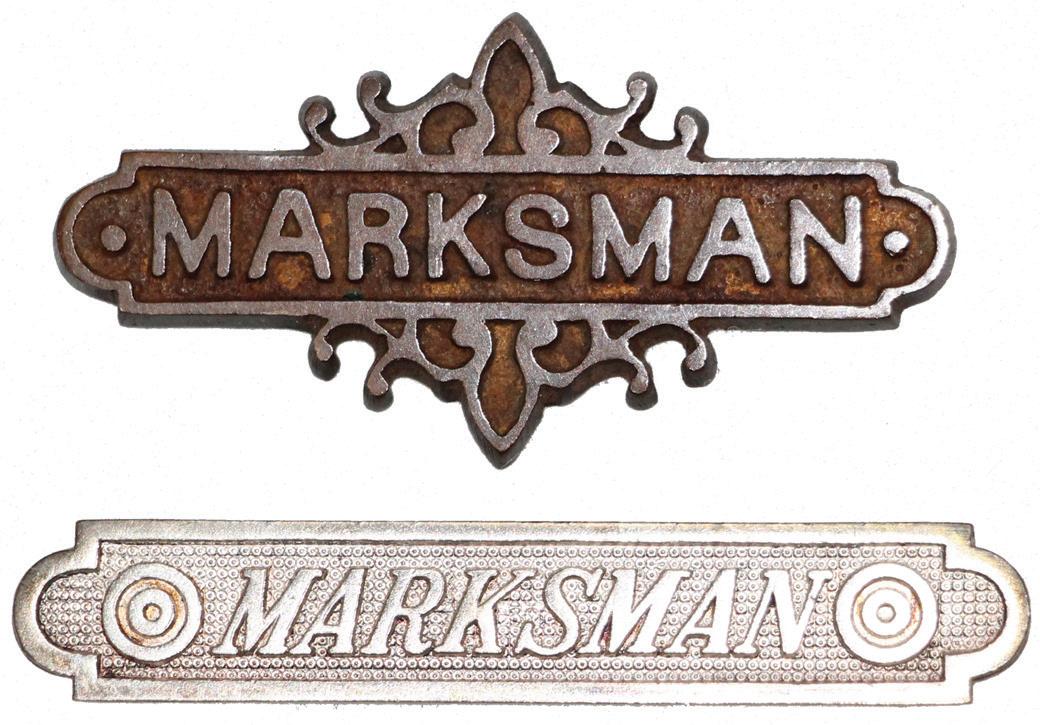
Regular Army soldiers also started to wear marksman buttons on their coat collars in 1881 if they qualified during annual firing. Regular Army marksman buttons lasted until 1897.4 Soon the Army added marksman bars, sharpshooter crosses, and after 1903, expert rifleman badges.5 At times expert qualification also entitled a man to extra pay.6
Between 1884 and 1897 the Army also issued to marksmen and sharpshooters, various certificates, most signed by general officers.7
In addition to these badges and certificates, during the 1880s and until 1902, the Army issued over twenty different styles of large, wearable gold, silver, and bronze prizes to soldiers who placed well in division, department, and Army level matches. In 1903, these large prizes were replaced by a wider range of smaller wearable prizes, still issued in gold, silver, and bronze, which were given in annual matches. That same year Congress provided funding to create the National Matches, trophies, and medals.
FIG 1. A small sample of marksman buttons worn on collars in state units. While the Regular Army stopped wearing marksman buttons in 1897, some National Guard units continued to wear them until just prior to World War I. All images courtesy of the author. FIG 3. One of the original Regular Army 1884 bronze sharpshooter crosses. Once a man qualified as a marksman, he could then fire an additional long range course in an attempt to qualify as a sharpshooter. In 1885 the silver version became the sharpshooter badge.
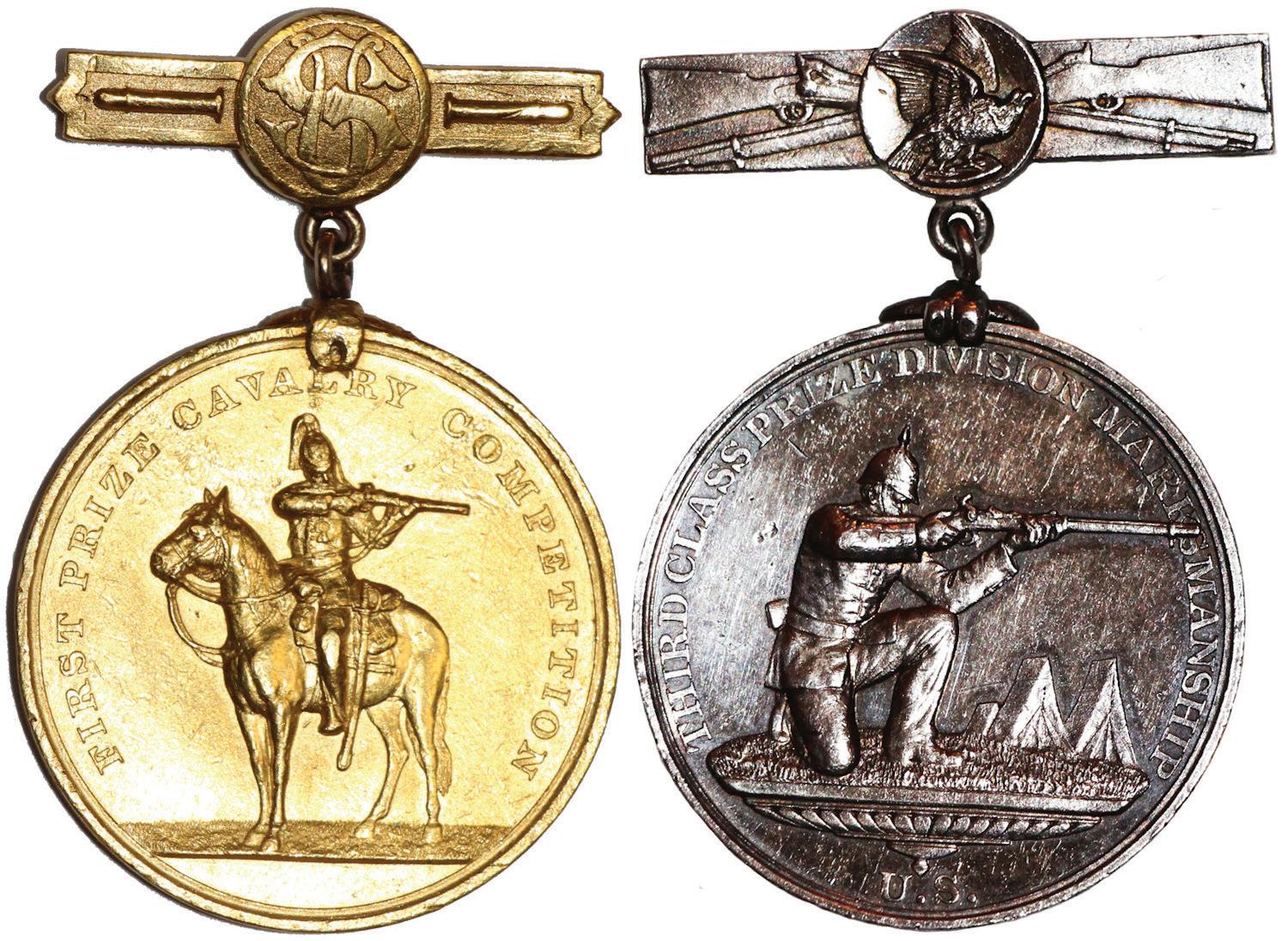
FIG 5. Two examples of the twenty-four prizes awarded in division, department, and Army matches between 1881 and 1902. Cpl. Charles Rie, Troop B, 6th Cavarly won the gold prize in the Division of the Missouri competition held at Fort Leavenworth, September 1897. The Army only awarded nineteen of these prizes. The silver prize was won by Sgt. James G. Harbord, Company A, 4th Infantry in August 1890 at the Division of the Pacific rifle match. Harbord later headed the AEF Services of Supply in France in 1918 then became the Army Deputy Chief of Staff when Pershing became the Army Chief of Staff. The Army only awarded thirty-seven of these prizes.

FIG 4. An 1887 sharpshooter certificate signed by Gen. Nelson Miles. It is 7.6 x 10.1 inches. As qualification requirements changed the Army modified the shooting certificate given to marksmen and sharpshooters, which resulted in several different versions. Certificates and badges helped to make qualification shooting popular with the troops. The National Matches were open to Regular Army and National Guard soldiers.8 The Marine Corps and Navy could compete but initially not win prizes, but that was soon changed by Congress, followed by a decision civilian teams could compete for National Match prizes.9
In the world of Army marksmanship contests, near the end of each summer divisions held matches with high scoring competitors receiving prize medals. A short time later these winners then vied in department matches. Again, top scorers won prizes and went on to the Armywide match. The top level match further resulted in the award of a small number of additional prizes. After 1903, the War Department simply named some of the Army level competitors that would make up the Army’s National Match team. The men were left to train on their own.
In the early National Matches, National Guard teams beat the U.S. Army. In the 1904 National Match, New York won. The U.S. Navy placed second followed by the infantry and then the cavalry.10 The next year was no better. New
FIG 6. Examples of silver and bronze prizes awarded by the Army between 1903 and 1916. In some cases the name of the division or department appeared on the suspending brooch while in other years DIVISION and DEPARTMENT were used.
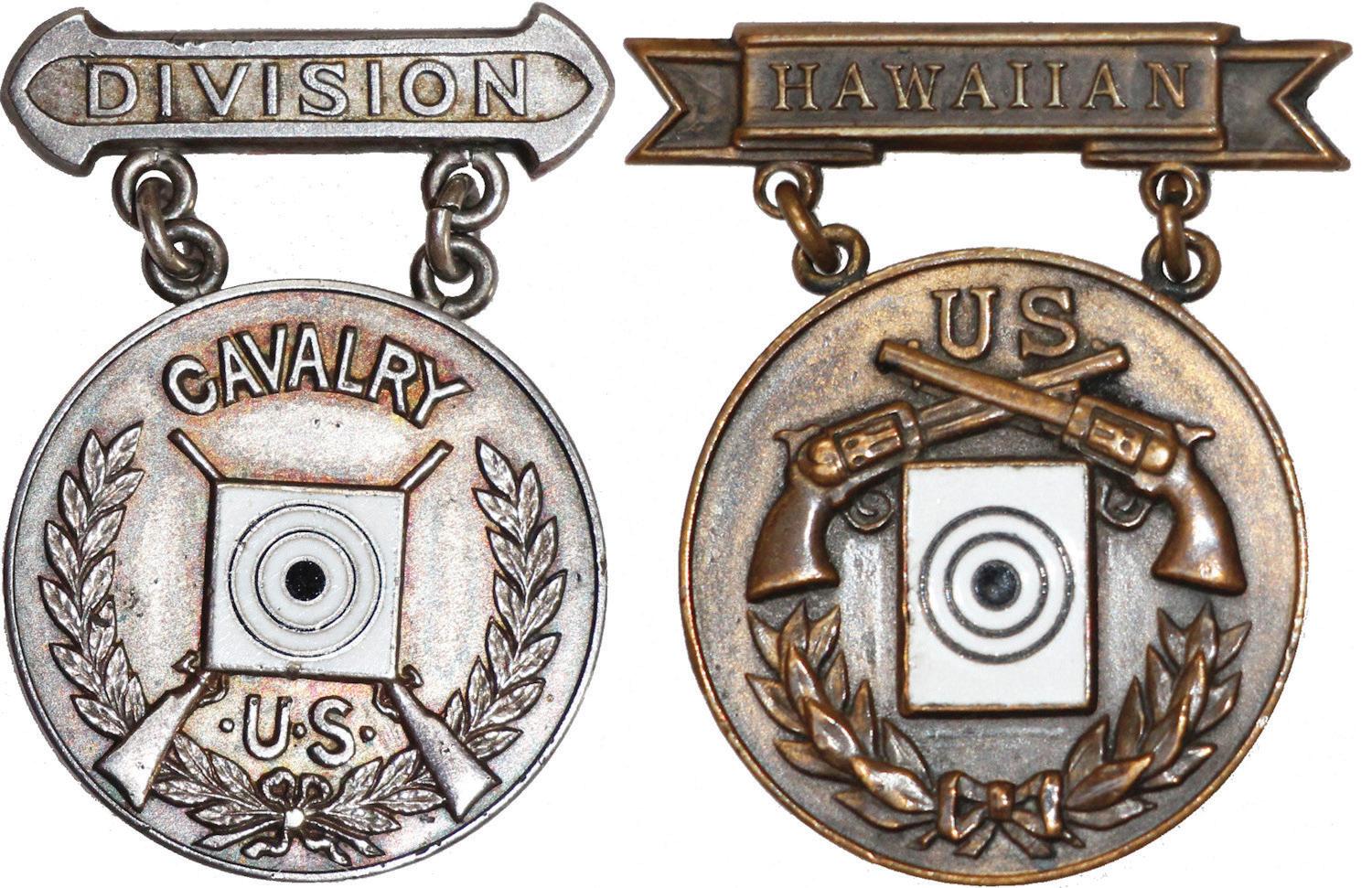
York won again, infantry placed second, Ohio National Guard third, the Marines fourth, while the cavalry slipped to 11th as other teams improved.11
It was too much for the War Department. Finally, in a desperate attempt to win the National Match, in 1906 the Army had the top 15 cavalry and the top 15 infantry shooters not fire in the division and Army level matches. This edict was so the two Army teams would train exclusively for the National Match.12
One root of the dilemma was the Army’s organizational structure. Generally during the latter part of the nineteenth century, the military divided the nation into approximately a half-dozen geographic divisions. The
FIG 7. Typical gold prizes won between 1903 and 1916 in division, department, and Army matches. Kerwin T. Smith, 6th Infantry, won these three medals. Left to right: First place award for the Army’s 1907 match; first place award in the Army’s 1908 match; and first place award for the Northern Division 1907 match. names and the number of divisions varied over time. The next higher headquarters were three departments that funneled paperwork to and from the Army’s headquarters and supervised the divisions. With the Spanish-American War and the Philippine Insurrection this peacetime structure proved not very adaptable. New divisions and departments came and went rapidly. These frequent changes caused annual division and department matches to be held on an irregular basis. Some divisions only lasted long enough to hold a single match.
To correct this problem, rather than select by division and department, in early 1906 the Military Secretary’s Office picked the 15 infantry and 15 cavalry shooters for the National Match. Team members were directed to train exclusively for the National Match. This required training prevented team members from shooting in division, department, and Army competitions. (At this time a team consisted of 12 firers, a coach, and 2 alternates.) Marksmen selected for one of the two National Match teams could not win any prizes at the three contests fired prior to the National Match. The fly in the ointment was a man had to win three prizes to become a distinguished marksman, but the National Match competitors could not win prizes at any lower level since they could not compete.13
Until 1919, National Match prizes were simple bronze shields as shown in FIG 8. After World War I, the Army tightened uniform regulations. Excluded from wear were

FIG 8. Until 1919 all National Match medals were bronze and of this general design. The inscription appearing at the bottom of the shield denoted the place represented by the medal—in this case the awardee was a member of the 2d place rifle team in the 1909 match. National Match bronze prizes. This left no way for a soldier to show he had been a National Match competitor. To correct this situation, in 1919 the Army introduced the two new gold team prizes—for Infantry Team and Cavalry Team members. These were for any soldier who “since and including 1906, shall have won a place as a principal or alternate on the Infantry or Cavalry rifle teams selected to represent the Army in the national matches.” Each man had to apply by letter to the Adjutant General for their gold badge. These badges were to count as one of the three awards necessary for distinguished marksman.14 The new 14-karat prizes had planchets 1¼ inches in diameter bearing a white and black enamel target centered over crossed rifles. Around the edge was a laurel wreath
FIG 9. Cavalry and infantry medals for National Match team awardees between 1906 and 1923.

with “U.S.” in the wreath’s top opening. Brooches that suspended the planches were 1½ inches long and 3/10 inches wide.
The reverse was engraved with the soldier’s name, rank, unit, and the year the person served on the national team, although as will be seen, the details of the engraving were not always consistent. Of the 1906–1919 badges examined, the author has noted use of the same engraving style. My presumption is these badges were engraved during the latter part of 1919 or early 1920, which would be consistent with the retroactive 1919 authorization.
One example of the engraving on a 1908 prize is in FIG 10. It shows the reverse of a gold Army Cavalry Team Medal engraved in lines that run across the medal, with slanted flowing script, “George M./Russell/1st Lieutenant/15th Cavalry/1908.” Lieutenant Russell attended the U.S. Military Academy, received a cavalry commission in 1901, and became a captain in 1916. In August 1917 he received a temporary commission as a field artillery major and became a lieutenant colonel in May 1918. He returned to Regular Army service as a major in 1920. Russell became a Regular Army lieutenant colonel in 1923 after receiving
FIG 10 FIG 13
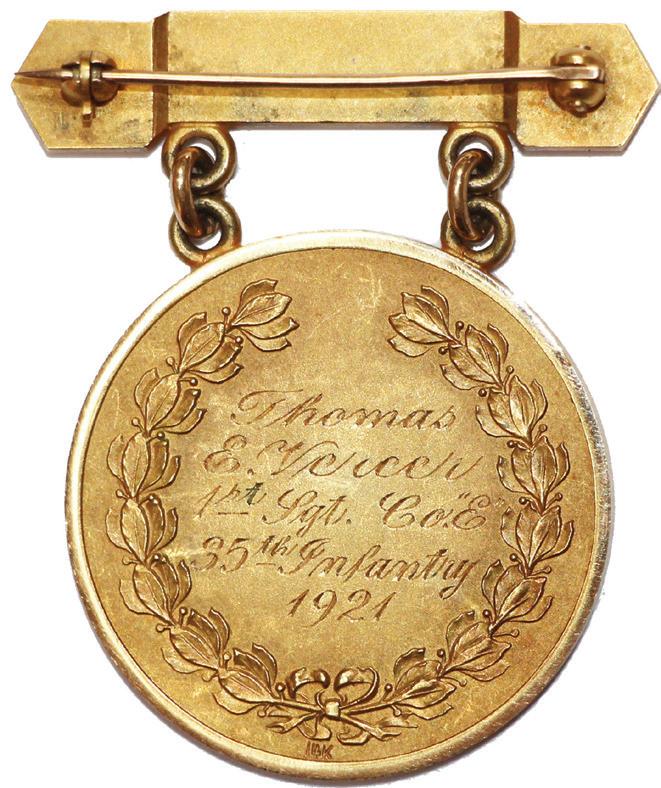

FIG 11

FIG 12
a Distinguished Service Medal for his wartime work. The Army promoted him to colonel in May 1931 and he died in Washington, D.C., on 17 August 1938.15
Despite World War I, in 1918 the Army took time and resources to field a rifle team. FIG 11 depicts the reverse of an Army Infantry Team Medal engraved in the same flowing script just seen, “Ralph W. Jacobi/2nd Lieutenant/3rd Infantry/1918.” Jacobi was a farmer from rural South Dakota who received a commission for the world war and by 1920 had been discharged.16 Both the Russell and Jacobi prizes have examples of engraving consistent with the theory the 1906–1919 badges were engraved right after the creation on these new prizes.
Examination of a 1920 Army Infantry Team Medal shows a significantly different engraving style. The reverse of Capt. Lewis Walters’ badge is shown in FIG 12. The lines run at an angle of about twenty degrees, left to right, the letters in each word being all upper case but with the first letters in a larger size than the subsequent letters. As the letters are larger, infantry is abbreviated so essential data could fit within the wreath. “LEWIS/D./WALTERS/ CAPTAIN/32ND INF./1920.”
Prizes from the following year returned to the neat cursive script used on prizes of 1919 and before. FIG 13 shows the soldier’s name on two lines, “Thomas/E. Veicci” with the third line abbreviation his rank and his company, “1st Sgt. Co. ‘E’” while the last two lines show his regiment and the competition year. The 35th Infantry was one of the regiments constituted in 1916. It saw no service in World War I as it was assigned to the 18th Division that stayed in Texas.17
In 1920, the coast artillery started to send a team to the national matches. Accordingly, that year a third badge appeared. The planchet was identical but the brooch carried ARTILLERY. Why the Army chose that wording rather than COAST ARTILLERY is lost to history but a review of the national match results for various years clearly lists the Coast Artillery Corps team.18
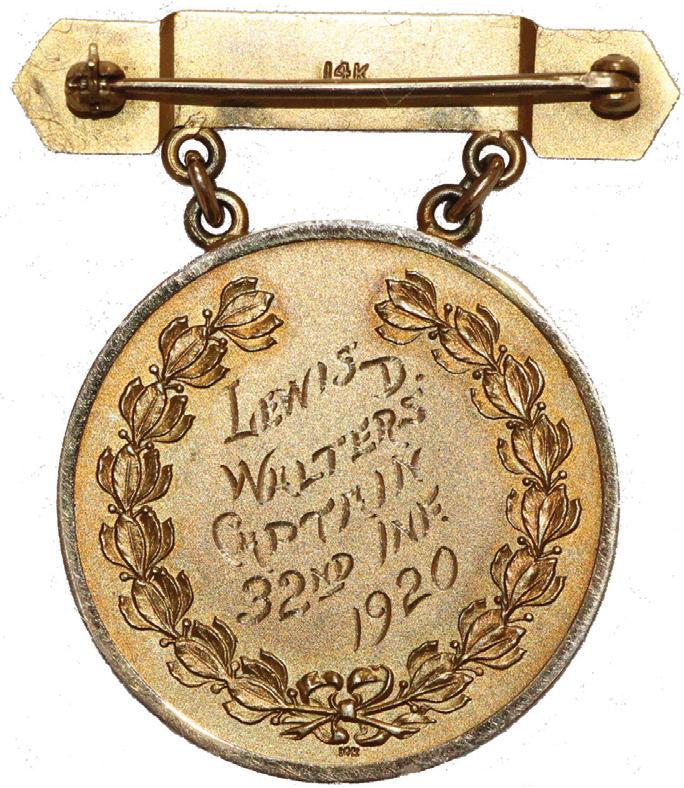
FIG 10. Reverse of the cavalry team medal awarded to George Russell. Most medals display this slanted script engraving with the name appearing on the first top one or two lines depending upon the length of the awardee’s name, followed by his rank, unit, and the year of competition. FIG 11. Reverse of the infantry team medal awarded to Ralph M. Jacobi for his participation in the 1918 match. This badge serves as an example of a team award with the name appearing in a single line. FIG 12. Badges for 1920 are the only awards that appear with a different style of engraving. This example was awarded to Capt. Lewis Walters, 32d Infantry. The inscription is slanted at an increasing angle, left to right. All lettering is in upper case, the first letters are larger than the letters that follow. “CAPTAIN” is written out, but INFANTRY is abbreviated as “INF.” FIG 13. First Sergeant Vereer’s 1921 infantry prize. It was engraved in the script used in years prior to and following 1920.
FIG 14. An example of a 1920 gold team prize with ARTILLERY brooch. Despite the name, these were for the coast artillery team as the field artillery did not send a rifle team in the early 1920s.
Another 1920 prize, given the first year the Army authorized artillery prizes, is one given to 1st Sgt. Louis Razga. He was born in Hungary, 14 August 1887, initially enlisted in 1908 for the coast artillery, and retired 25 July 1935 as master sergeant. In France with the AEF he was wounded and worked at Pershing’s headquarters. Two of Razga’s awards survive, including his gold artillery team prize, shown in FIG 15. It is engraved, “LOUIS/RAZGA/1ST SERGT./BATTERY C/52ND ARTILLERY/C. A. C. 1920.” The artillery team placed tenth overall and Razga tied for third within the team with a score of 275.19
First Sgt. Louis Razga was a pall bearer for the Unknown Soldier, November 1921. Among his papers are an original pass to, “Memorial Ceremonies for an Unknown American” on capital grounds for 11 November 1921, a pass for Razga while he was in France and was in 58th Artillery, his warrant as a sergeant in the 4th Coast Artillery Corps Company dated 1917, a warrant as first sergeant dated 1924 in the 52d Coast Artillery (Railway), Razga’s retirement certificate signed by the acting adjutant general, and his pass to the internment ceremony for the Unknown Soldier. A photo of Razga taken between 1921 and 1924 is in FIG 16.
His other surviving Regular Army medal is his Purple Heart, number 851, which shows it was one of the very early medals issued in 1932. It is engraved on the reverse, “LOUIS RAZGA” and is shown in FIG 17. Razga died 8 February 1959 and was buried in Longwood Cemetery, Kennett Square, Pennsylvania.
At least one man won three of the gold team prizes: James T. Campbell.


FIG 15. Sergeant Razga’s 1920 prize is engraved in the same style as that used for Captain Walters (FIG 12).

FIG 17. Obverse and reverse of Sergeant Razga’s Purple Heart that is numbered 851.

FIG 16. First Sgt. Louis Razga, a pall bearer for the Unknown Soldier, November 1921, wearing his shooting awards including his 1920 artillery team prize.
Campbell graduated from Plattsburg Barracks Training School in 1917 and received a lieutenant’s commission. He served in France as a member of the 33d Division. Between 1921 and 1923 he became a competitive marksman and was a member of the coast artillery team. The unit to which he belonged in the Panama Canal Zone during this time was constituted as the 4th Coast Artillery Regiment in 1924. During World War II, Campbell commanded the 118th AAA Group during the Battle of the Bulge. He retired as colonel in 1946.
His first two prizes were of the type with ARTILLERY on the brooch. This was despite the fact the field artillery did not have a rifle team (its primary individual arm was the pistol while the coast artillery had the rifle as its primary small arm for most units).20
The reverse of Campbell’s 1921 prize is shown in FIG 18. It is script engraved, “James T. Campbell/ Captain/C. A. C./1921.” The reverse of his second prize is in FIG 19, engraved, “James T. Campbell/Captain/Coast Arty Corps/1922.” Beside the year, the only difference is in the way his branch is shown: “C.A.C.” versus “Coast Arty. Corps.”
In 1923, Campbell received his third gold team badge, but by this time new dies had been made. Campbell’s overall design was similar to the earlier prizes with the most obvious change on the brooch with COAST ARTILLERY (FIG 20). Why the Army struck a totally new planchet and brooch whose lines were not as fine as the initial striking is unknown.
The details of the coast artillery prize are not as crisp as with all of the other prizes. The diesinker obviously spent less time on the artistic details. The wreath has significantly less detail, as do the crossed rifles. The enameled target is slightly smaller, while the “U.S.” letters above the target are noticeably thicker and larger.
The reverse of Campbell’s 1923 prize struck from the new die is shown in FIG 21. While the overall design is the same with a laurel wreath near the edge, the wreath has more depth than all of the other team prizes. It is engraved slightly differently than his other two prizes, “Captain/ James T. Campbell/Coast Artillery/1923.” Of the gold prizes I have examined, this is the only case where a rank comes first. In addition his branch is “Coast Artillery,” still a different way of listing his arm of service. It is interesting to note all three of Campbell’s medals have the engraving in slightly different styles.
Initially 18 men comprised a team: 12 firers, 3 alternates, 1 coach, 1 team captain, and 1 spotter.21 The next year the cavalry team had 18 members, as before, although 3 were from the Corps of Engineers. Capt. Malin Craig, 1st Cavalry, and later Chief of Staff of the Army, was the coach. The infantry had seventeen members including one from the coast artillery. The coach was one of the firers, in an unusual move.22 By 1908 regulations were simply calling for twelve-man teams, although the regulations still allowed for two alternates, a coach, a captain, and a spotter. Twelve-man teams continued into 1916.23
In 1914, the Army, for just that year, changed the manner the National Matches were held. To encourage more National Guard teams to participate, a set of four matches were held around the nation. Teams traveled to the sites closest to their home base in an effort to have more state teams fire. With dispersed firing, the Army initially planned to send a team to each of the firing locations, but in the end, the Army for once, did not send a cavalry
FIG 18 FIG 19 FIG 20



FIG 18. The engraved reverse of James Campbell’s artillery team medal for 1921. FIG 19. Campbell’s 1922 artillery team medal. The award was engraved “Coast Arty. Corps.” rather than “C.A.C.” FIG 20. One of the prizes made for 1923 whose top bar engraved “COAST ARTILLERY” rather than simply “ARTILLERY.” In addition to the brooch the Army fabricated a new die for the 1¼-inch planchets. Although the design had not changed, the new version was not as distinct in appearance as with those produced prior to 1923.
FIG 21. The coast artillery team prize of 1923 awarded to James Campbell. His “unit” received a medal containing yet another change in its wording—in this case “Coast Artillery.”
or infantry team.24 This resulted in no gold team medals being awarded that year. National Matches were held in 1916, but because of problems on the Mexican border, the Army decided not to send any teams. With the entry of the U.S. into World War I, the Army suspended the national matches for 1917.25
The next year, however, the infantry participated by sending one team as witnessed by Lieutenant Jacobi’s prize (FIG 11). The Army placed 17th.. For once the Navy sent 12 teams, the Marines sent 2, while the cavalry had 1 that placed 7th.26 Teams continued to consist of 12 firers from 1918 to 1920, then with the 1921 match, teams were reduced to 10 members. Ten-man teams remained through 1923 when use of the gold team medals ended.27
Complicating counting of possible medals was a change of rules regarding the number of Army teams that could fire. Through 1915 the Army entered two teams: infantry and cavalry.28 The 1916 regulations allowed three teams by adding one for the coast artillery, although as noted, the Regular Army sent no teams.29 National Match regulations of 1918 and later allowed the Army to send “one or more” teams.30 In 1920, the Army’s infantry team won. For the first time a team from the Philippine Scouts placed 5th, the cavalry placing 7th and in its first match, the coast artillery came in 10th. There was no special gold medal for the Philippine Scout team in which each firer was an NCO, although each man did receive another medal.31
If one considers the annual firers and two alternates could have received medals, Table I summarizes the possible gold team medals. Since infantry and cavalry teams were eligible for the gold prizes throughout their life, they are the most common, although at most 206 of each were awarded. Badges with artillery brooches are considerably scarcer since they were available for only three years, but the coast artillery version had only a dozen awarded.
How many of these gold team medals did the Army issue? Since the Army required shooters write in and request one of the prizes, it is hard to tell. Most firers certainly asked for their gold badges.

Table 1. Maximum Possible Gold Team Medals
Title on Brooch
Infantry
Years Team Fired
1906–13, 1915, 1918–20, 1921–23*
Possible Medals
206
Cavalry Artillery 1906–13, 1915, 1918–20, 1921–23* 1920, 1921–22* 206 38
Coast Artillery 1923* 12
* Starting in 1921 teams were of 10 men with two alternates. Earlier teams had 12 men and two alternates except 1906 had three alternates.
In September 1922, the Quartermaster Corps announced a new set of prizes to replace the division, department, and Army prizes introduced since 1903.32 These 1903 and subsequent badges had undergone various modifications, including changes in sizes, introduction of many new brooches impressed with division and department names and other notations including AEF that was used in the Army’s largest shooting contest, which was held near LeMans, France, in May 1919.33
The 1922 style badges were comprised of three parts. For National and Army matches the top bronze rectangular brooch displayed oak leaves. For lower matches, held at department and corps areas, the brooch was a thin bronze bar with a center disk showing either the corps area number or a department symbol. Below a brooch was one of three clasps that depicted crossed weapons: pistols, rifles, or automatic rifles. All clasps were bronze for national and Army matches, while for lower matches the top one-sixth of prize winners received gold clasps, the next one-third had silver clasps, and the bottom half had bronze clasps.34
Planchets of the 1922 design featured a bow and two arrows, surrounded by thirteen stars, which in turn had a laurel wreath around the edge. Corps area and department planchets were all bronze, while those given at Army and national matches had the ring of stars enameled in branch color(s).35
In 1924 match regulations changed so “each of the (Army) branches” could have a team at the national matches. Rather than continue to issue the gold team prizes, the 1922 pattern prizes now allowed the Army to use the bronze and enamel awards in their place at a considerably reduced cost.36 This spelled the end of the short-lived gold team prizes. Various matches had been held in 1916 and later, and at times the Army did not provide 1903-type prizes. With the adoption of the 1922 prizes the Army retroactively awarded the new bronze badges for these matches.37 One example is in FIG 22.
Notes
FIG 22. A 1922 style National Match named prize to an officer in the Philippine Scouts that was awarded retroactively. National match prizes contained enameled stars and ring—in this case dark blue with red stars for the Philippine Scouts. Weapons clasps for Army and national matches were always struck in bronze. It appears with, “1st Lieut./Frank Christian/Inf. P.S./1921” engraved in script. Christian served as an enlisted man in the 6th Infantry between 1911 and 1914, and subsequently in the National Army’s 151st Depot Brigade in 1918. He received a commission in the Philippine Scouts in August 1918.

FIG 23. Corps area prizes struck in 1922 contained a top bar engraved with either the corps area number or a design intended specifically for the Canal Zone, Hawaii, or Philippine departments. Weapons clasps were made of gold, silver, or bronze to depict placement in the match while the ring of thirteen stars on the planchets was always composed of bronze without any enamel.

1.
2.
3. War Department (WD), Annual Report, Secretary of War, 1860 (Washington: GPO, 1860), 984. George W. Wingate, Manual for Rifle Practice, 6th ed. (New York: Army and Navy Journal, 1878), ii; George W. Wingate, Manual for Rifle Practice, 5th ed. (New York: Army and Navy Journal, 1875), 144. T. T. S. Ladley, Colonel Laidley’s Reply to the Charge of Infringement of Colonel Wingate’s Copyright (Boston: Mills,
Knight & Co., 1879). 4. WD, Annual Report, Chief of Ordnance, 1881 (Washington: GPO, 1881), 31; WD, Adjutant General’s Office (AGO), General Orders (GO) 36, paras 500c and 510. 5. WD, Annual Report, Chief of Ordnance, 1885 (Washington: GPO, 1885), 626–29; WD, Firing Regulations for Small Arms for the
United States and the Organized Militia of the United States, 1904 (Washington: GPO, 1904). 6. Headquarters of the Army (HQA), AGO, GO 24, 1903, 5. 7. HQA, AGO, WD Circular 6, 1884; HQA, AGO, GO 12, 1884; WD,
AGO, GO 36, 1897, para 500h. Examination of various certificates by the author. 8. WD, Annual Report, Secretary of War, 1903 (Washington: GPO, 1903), 423. 9. WD, GO, 76, 1904, 36. 10. WD, GO 172, 1904, 2. 11. WD, GO 104, 1905, 20. 12. File #1632150, Records of the Old Records Division, Records of the Adjutant General, 1780s–1917, Record Group (RG) 94,
National Archives, Washington DC (NA); File # 1204992, Military
Secretary’s Office (box 3244), RG 94, NA; WD, GO 44, 1907. 13. Ibid. 14. WD, Bul. 29, 1919, sect III; WD, Bul 39, 1919, sect III. 15. AGO, Official Army Register 1934 (Washington: GPO, 1934), 596;
Association of Graduates, USMA, Register of Graduates (Chicago:
R. E. Donnelley & Sons, 1980), 290. 16. U.S. Census, 1930, Buffalo Township, Harding County, SD, district 0001, sheet 2. 1920 census for Harding County, SD. 17. The Army Lineage Book: Vol II: Infantry (Washington, DC: GPO, 1953), 163. 18. WD, Bul. 1, 1922, 2. 19. WD, Bul. 41, 1920, Tables I and XI. 20. Willard W. Irvine, “The Policy of the Coast Artillery on Small Arms
Equipment and Training,” Coast Artillery Journal (May 1926): 459; WD, Provisional Drill and Service Regulations for Field
Artillery (Horse and Light), 1916 (Washington: GPO, 1917), para 28. 21. WD, GO 56, 1906, 3. 22. WD GO 162, 1907, 1–2. 23. WD, GO 26, 1908, 1–3. WD; Buls 6 and 37, 1916. 24. WD, Bul. 11, 1914, para 4; Bul. 36, 1914, para. 1; Bul. 51, 1914, Sect.
III. 25. WD, Bul. 14, 1916, Sect. IV. WD; Bul 29, 1917, Sect V. 26. WD, Bul. 17, 1919, 2. 27. WD, Bul. 6, 1920, para. 3 and WD Bul. 4, 1921, para 3; WD Bul. 10, 1923, para. 3. 28. WD, Bul. 10, 1915, para. 6a. 29. WD, Bul. 8, 1916, para. 4a. 30. WD, Bul .18, 1919, para. 3a; WD, Bul 6, 1920, para. 3a. 31. WD, Bul. 41, 1920, Tables I and VI. 32. WD, Changes 5 to AR 600–35, September 1922, para. 39d. 33. GHQ AEF, Bul. 7, 1919; GHQ AEF, Bul. 29, 1919. 34. WD, Changes 5 to AR 600–35, September 1922, para. 39d. 35. Ibid.; WD, Office of Quartermaster General drawing 4-4-16, April 18, 1923. 36. WD, Bul. 7, 1924, para. 3. 37. Observations of many prizes by author over 20 years.










